Cybernetics, Computer Design, and a Meeting of the Minds
In Paris. Exactly seventy years ago.
He likely arrived in Paris from Darmstadt, Germany, by train that January. At 53, and a full professor of applied mathematics and the founding director of the Institut fur Praktische Mathematik at the Technische Hochschule Darmstadt, Alwin Walther was among Germany's leading figures in computation. The calculational prowess of Walther and his institute-employing all manner of manual, mechanical, and electromechanical approaches-had attracted the attention, and the support, of the Nazi regime during the Second World War. But as Walther made his way to the academic heart of liberated Paris, the Latin Quarter, few passersby would have guessed at this background.
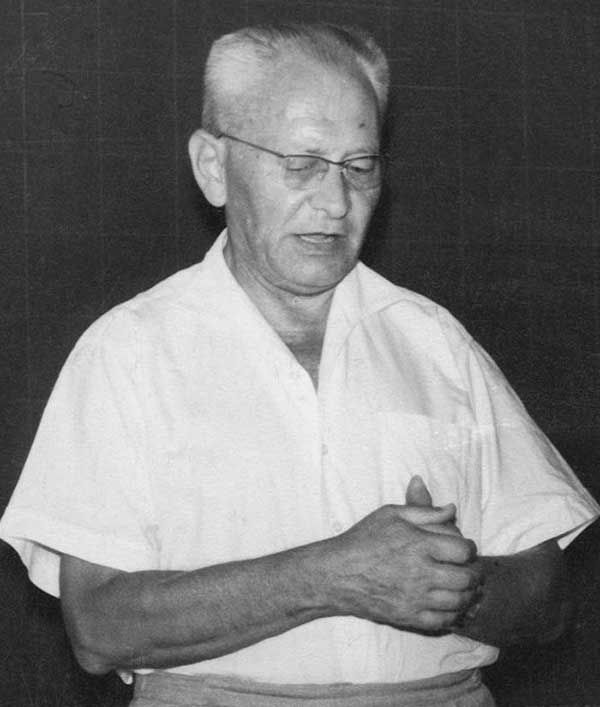 Photo: Gerhard Hund /Wikipedia Alwin Walther, founding director of the Institut fur Praktische Mathematik at the Technische Hochschule Darmstadt.
Photo: Gerhard Hund /Wikipedia Alwin Walther, founding director of the Institut fur Praktische Mathematik at the Technische Hochschule Darmstadt. Walther's institute had been a major source of the calculational support needed for Werner von Braun's rocketry efforts, most notably the V-2, for the Germany Army. Indeed, during the war, Walther secured funding from the German Army to create an advanced electromechanical analog computer: an advanced differential analyzer to rival that created earlier by Vannevar Bush at MIT. (The German system, the IPM-Ott DGM, was developed throughout the war, but only delivered to Walther's institute in 1948.)
This work with von Braun and the German Army was not the only effort that connected Alwin Walther with slave labor, like that from German concentration camps exploited in the V-2 rocket factories. More directly, Walther was evidently involved in a scheme with the Nazi SS to enslave Jewish scientists held in the Sachsenhausen concentration camp to perform manual calculations. If the scheme actually had been put in place, which is unclear, it was soon upended, along with the other activities of Walther's institute, when its facilities, the vast majority of the buildings of the Technische Hochschule Darmstadt, and much of the rest of the city were destroyed during Allied air raids on 11 and 12 September 1944.
 Photo: Photoquest/Getty Images Darmstadt after the 1944 bombing raids, which killed thousands of people.
Photo: Photoquest/Getty Images Darmstadt after the 1944 bombing raids, which killed thousands of people. In new facilities created after the war, Walther and his institute had their eyes firmly set on electronic digital computing. During the war, members of the institute and its machine shop had provided direct support for Konrad Zuse's famed electromechanical Z4 computer. (The Z4 was a pioneering digital computer, originally intended for use in the German aircraft industry.)
Walther himself developed wartime plans for a large electromechanical computer along the lines of Howard Aiken's Mark 1, but those were abandoned. As Walther packed his belongings for his January 1951 trip to Paris, he and his institute had just embarked on a major new effort to create a stored-program, electronic digital computer. This machine, the Darmstadter Elektronischer Rechenautomat, or DERA, would become operational in 1957 (more on that later).
Surely, Walther must have had with him in Paris a particular bundle of papers: his copies of the announcement, printed schedule, registrant list, and both French and English sets of presentation abstracts for the international conference he was attending in Paris from the afternoon of Monday, 8 January 1951, through the afternoon of Saturday, 13 January.
The rise of the computing view of human thoughtThe conference was organized by the Institut Blaise Pascal, the computing center founded in 1946 by the French scientific and engineering research establishment, the Centre National de la Research Scientifique (CNRS). The French institute was composed of two laboratories, one devoted to analog computation and the other, led by Louis Couffignal, to digital computation. It was Couffignal who was the principal figure behind the January 1951 international conference.
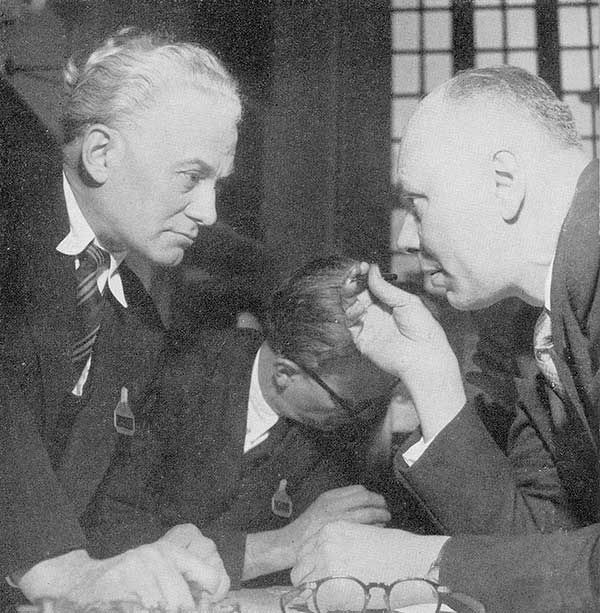 Photo: Charles Babbage Institute Archives, University of Minnesota Libraries Louis Couffignal [left], director of the digital computation lab at the Institut Blaise Pascal, with Howard Aiken, designer of the Harvard Mark I, at the Paris conference in January 1951.
Photo: Charles Babbage Institute Archives, University of Minnesota Libraries Louis Couffignal [left], director of the digital computation lab at the Institut Blaise Pascal, with Howard Aiken, designer of the Harvard Mark I, at the Paris conference in January 1951. Couffignal had completed a doctorate in mathematics on the theory of computation at the University of Paris in 1938, with the ambition to create a new binary-based calculating machine. During the wartime occupation of the city by the Germans, Couffignal had met intensely and often with perhaps France's leading physiologist, Louis Lapicque.
Lapicque, famed for his integrate-and-fire model of the neuron, and Couffignal found a common vision, seeing deep analogies and connections between the processes and physiology of human thought and the processes and componentry of calculating machines. Imprisoned by the German Gestapo for aiding the resistance, Lapicque nevertheless managed to write his book La Machine Nerveuse, which was published in 1943. In it, Lapicque gave voice to this vision shared with Couffignal: The regular periodic organization of cerebellar elements made cerebellum close to artificial machines. Some of its processes may be understood by comparison with calculating machine or automatic telephone relays."
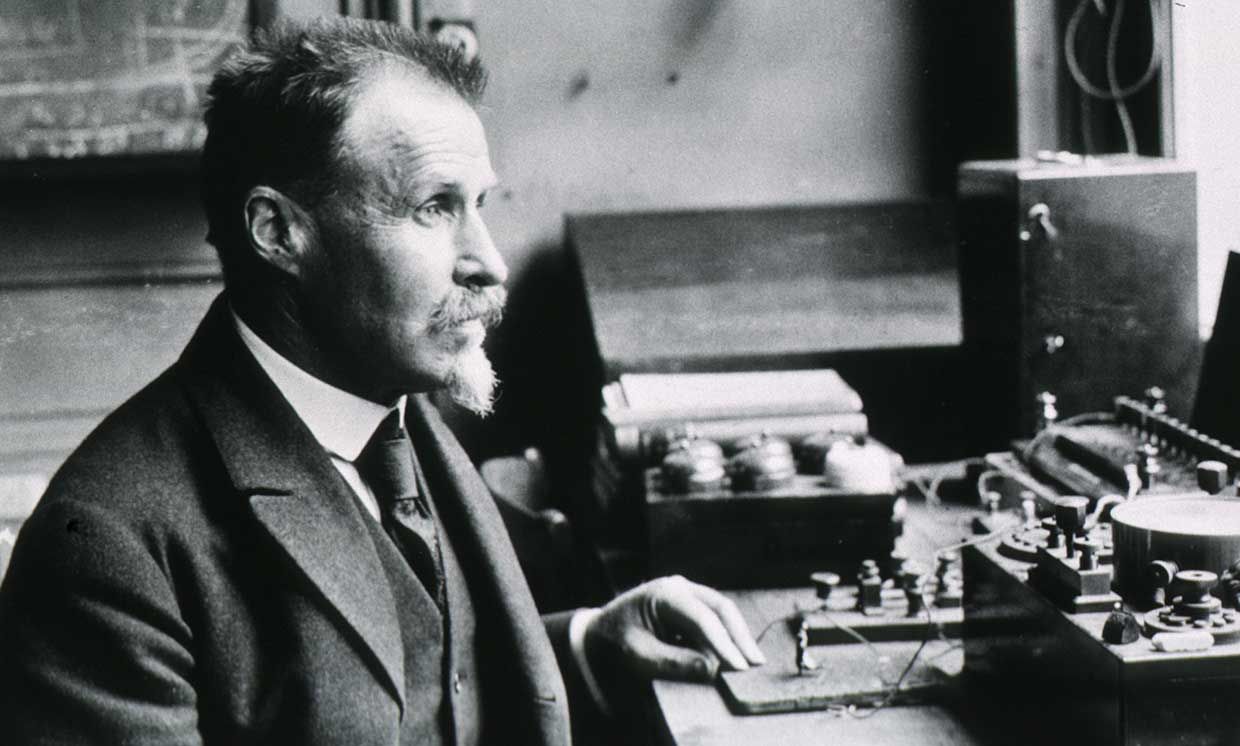 Photo: U.S. National Library of Medicine French neurophysiologist Louis Lapicque saw connections between human thought and computational processes.
Photo: U.S. National Library of Medicine French neurophysiologist Louis Lapicque saw connections between human thought and computational processes. Like many who came before them, Couffignal and Lapicque were using human-made tools of great current fascination as analogical tools for understanding human bodies and minds. Where earlier thinkers had been entranced with clockworks, seeing themselves in the gears and windings, Couffignal, Lapicque, and others of the 1940s looked at electromechanical and electronic calculating machines and saw human bodies and minds mirrored therein.
Working for the CNRS during the war positioned Couffignal to take up leadership of the digital computing laboratory of the Institut Blaise Pascal in 1946. At the time, the institute was equipped only with desktop electromechanical calculators confiscated from the Germans, but Couffignal was fired with ambition to make a new, French, binary computer.
In the first year of his new directorship, he traveled to the United States to deepen his understanding of American developments in both electronic computing and what we might call the computing-view of human thinking." In Philadelphia, he familiarized himself with ENIAC. (ENIAC was a newly completed, all-electronic digital computer, and a milestone in the history of computing.) In Princeton, Couffignal learned about the development of the Institute for Advanced Study computer by John von Neumann. (The IAS computer was a stored program" machine, holding both software and data in its memory. The power of this approach made the computer a model for many early digital computers around the world.) At Harvard, Couffignal visited Howard Aiken and saw his electromechanical computers.
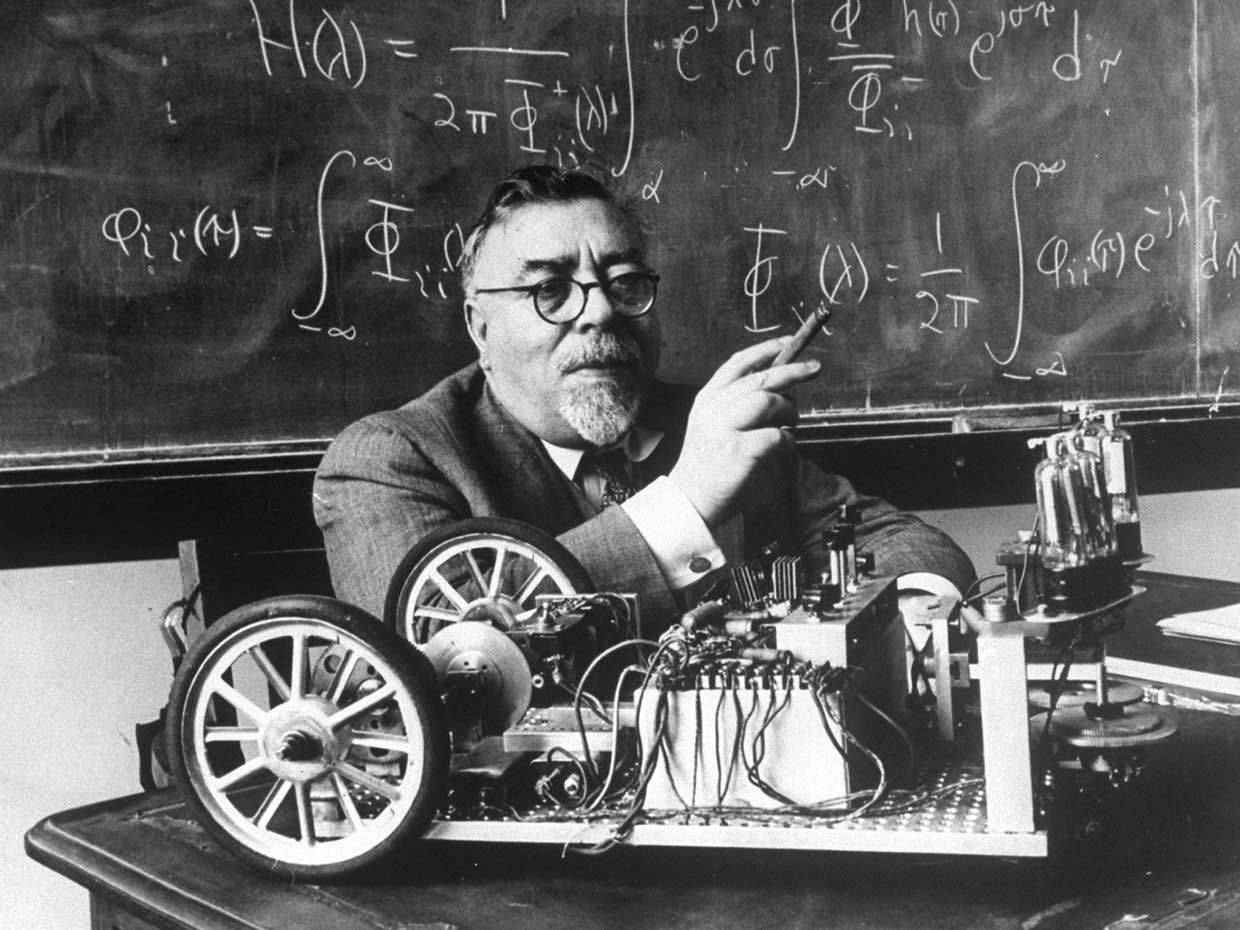 Photo: Alfred Eisenstaedt/The LIFE Picture Collection/Getty Images MIT mathematician Norbert Wiener with his cybernetic moth-bedbug.
Photo: Alfred Eisenstaedt/The LIFE Picture Collection/Getty Images MIT mathematician Norbert Wiener with his cybernetic moth-bedbug. It was also in Cambridge that Couffignal found the chance to pursue his interest in the computing-view of human thought, when he met with the mathematician Norbert Wiener at MIT. Deep into the work that would lead him to publish his book Cybernetics: Or Control and Communication in the Animal and the Machine in 1948, Wiener evidently found a kindred spirit in Couffignal. In 1947, Wiener returned the visit, meeting with Couffignal and Lapicque in Paris.
The French computer: Couffignal's pilot-machineThe same sort of analogic thinking that led Couffignal, Lapicque, and Wiener to see bodies and minds as servomechanisms (an automatic control based on feedback), electromechanical relays, and electronic circuits had, by 1951, also led Couffignal to steer France's main effort to develop a large-scale digital electronic computer in a very particular direction. As early as his 1938 doctoral thesis, Couffignal was already engaged in analogic thinking about calculating machines that connected with physiology. He wrote, To give a full account of the development (of calculating machines) we must create for machinery the analogues of comparative anatomy and physiology." What Couffignal concluded, in short, was that this physiology of calculating machines displayed an evolution in which increased calculating power was achieved by increasing complexity.
In 1947, when Couffignal had control of France's major effort to build a large-scale digital computer, his evolutionary conclusion of 1938 now carried real weight. France's computer would depart from the designs he saw in America, which in his comparative anatomy" of computer design embraced a simplicity of calculation logic, thereby emphasizing the need for large memories. This was, for Couffignal, a kind of devolution, a reversion against complexity and therefore progress. France's computer, in contrast, would embrace large, parallel units of complex calculating logic, and minimize, even eliminate, memory. In this, Couffignal explained, the problem of organizing a calculation is essentially the same as that of organizing a factory assembly line."
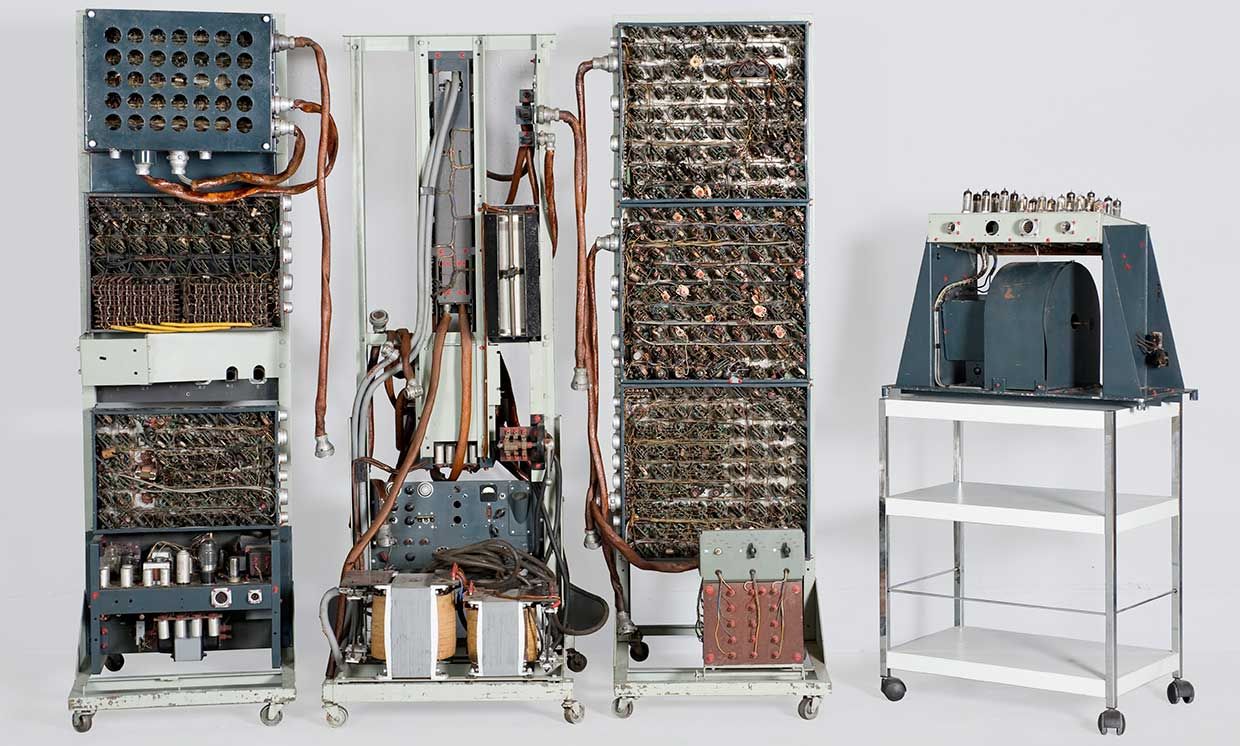 Photo: Charlotte Compan/Musee des Arts et Metiers-Cnam Louis Couffignal's pilot-machine could calculate square roots and sine functions.
Photo: Charlotte Compan/Musee des Arts et Metiers-Cnam Louis Couffignal's pilot-machine could calculate square roots and sine functions. By January 1951, a pilot-machine" embodying Couffignal's strikingly different approach to electronic digital computing was in operation within his laboratory of the Institut Blaise Pascal. It was the result of four years of effort by the principal contractor, the Logabax Company, and the expenditure of millions of francs by the CNRS. Whatever else one might say of it, it could actually compute, able to calculate square roots and sine functions.
Cyberneticists and others converge on ParisThrough the auspices of the CNRS, and with some additional funding from the Rockefeller Foundation, and with his pilot-machine ready to demonstrate, Couffignal organized an ambitious international conference that combined his two greatest passions: large-scale digital electronic computers and the computing-view of human thought. The conference gathered together some of the leading lights of digital computer development from across the world, as well as an international coterie of researchers inspired by the view of the mind as a machine. After 1948, when Wiener's book spun the term into circulation, this later group would be known as devotees of cybernetics.
The conference was titled Les Machines a Calculer et la Pensee Humaine" (Computing Machines and Human Thought) and was held in the meeting rooms of the Centre National de Documentation Pedagogique-the French state's educational publishing arm-located just a three-minute stroll from Couffignal's laboratory in the Institut Henri Poincare, around the corner at 29 Rue d'Ulm.
A distributed Liste Alphabetique des Membres du Colloque" presented a roster of attendees, along with their affiliations. The roster became data for Alwin Walther to analyze, perhaps on his way from Darmstadt to Paris. Pencil in hand, he annotated each page of the list, counting the distribution of attendees by country. What motivated his survey of the conference's geographic diversity is unclear, but what is undoubted is that he noted that he was the single German to attend. 1 Allemande," he scribbled in his final count; 5 from the USA; 184 from France; 40 from the UK; 5 from Spain; 8 from the Netherlands; 6 from Belgium; 4 from Italy; 4 from Sweden; 1 from Switzerland; 1 from Germany; and 1 from Brazil. The 259 attendees were occupationally diverse as well, hailing from universities, telecommunications firms, medical institutions, military organizations, computer manufacturers, academic and professional societies, journalism, diplomacy, industry, the UN, and museums.
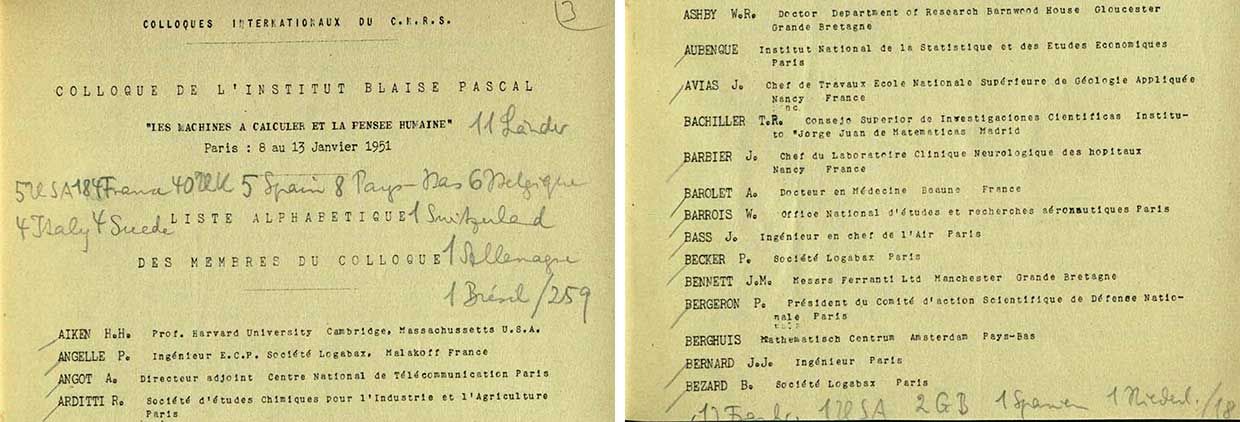 Images: Computer History Museum Alwin Walther noted the nationalities of the Paris conference attendees. He was the sole participant from Germany.
Images: Computer History Museum Alwin Walther noted the nationalities of the Paris conference attendees. He was the sole participant from Germany. The six days of the conference were broken into three two-day parts. The opening part focused on Progres Recents dans la Technique des Grosses Machines a Calculer," new developments in the approach to large-scale digital computers. Quantum physics pioneer, Nobel Laureate, and Secretary of the Academie des Sciences Louis de Broglie delivered the opening welcome and was followed by a series of presentations on the latest electronic digital computers. Harvard's Howard Aiken spoke about his Mark II, III, and IV machines.
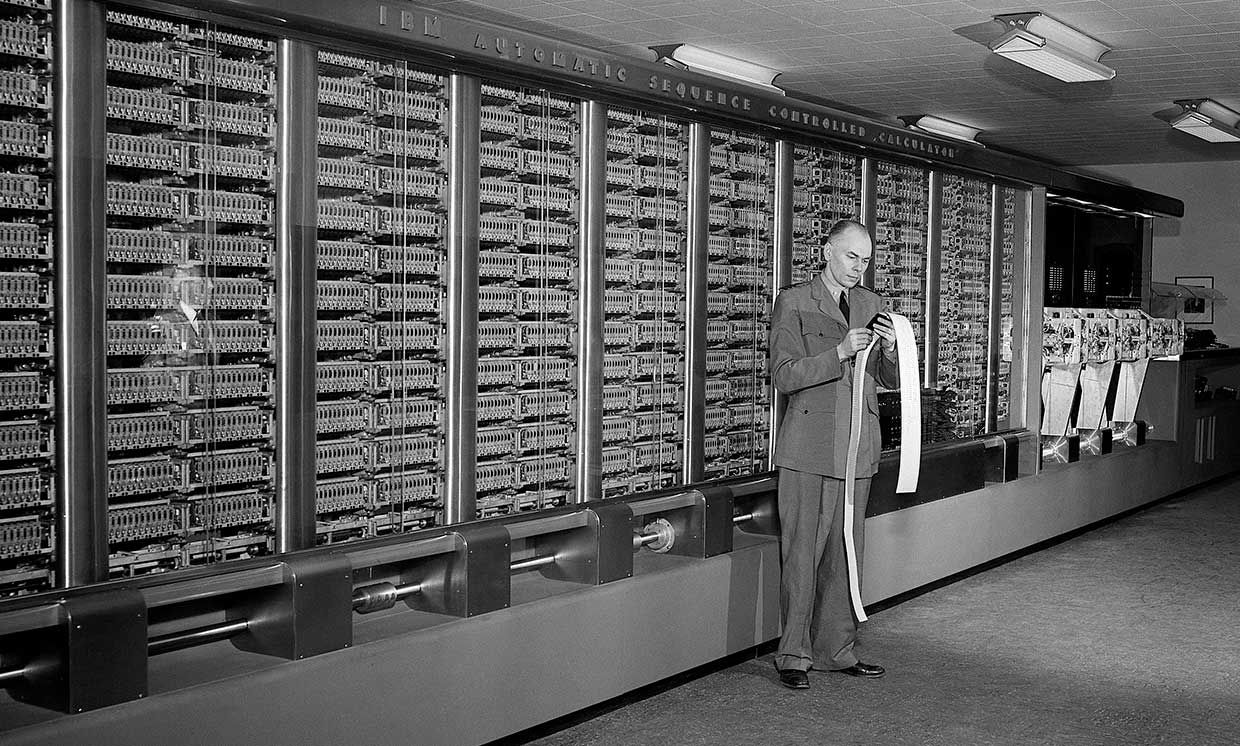 Photo: Bettmann/Getty Images Howard Aiken with the Harvard Mark I. Built by IBM, it was completed in 1944.
Photo: Bettmann/Getty Images Howard Aiken with the Harvard Mark I. Built by IBM, it was completed in 1944. Birkbeck College's Andrew Booth described his experimental SEC and his new APEXC computer. Eduard Stiefel, head of applied mathematics at ETH Zurich, spoke of Konrad Zuse's Z4 computer, now under Stiefel's care. E.W. Cannon, a leader for mathematics at the U.S. National Bureau of Standards, surveyed the organization's history with computing, including SEAC and SWAC. F.C. Colebrook of the UK's National Physical Laboratory described recent success with the Pilot ACE computer, originally designed by Alan Turing. At the close of the first day, Couffignal demonstrated his laboratory's pilot-machine, its world debut.
A chess-playing machine and other computational curiosities Photo: Harry Todd/Fox Photos/Getty Images Maurice Wilkes, director of the University of Cambridge's Mathematical Laboratory, examines the results of an EDSAC calculation.
Photo: Harry Todd/Fox Photos/Getty Images Maurice Wilkes, director of the University of Cambridge's Mathematical Laboratory, examines the results of an EDSAC calculation. The second day continued with presentations about additional new computing work, such as Freddie Williams' review of computer work at the University of Manchester, and discussions of various digital and analog computing approaches.
The middle part of the conference was devoted to the kinds of mathematical and scientific problems that were appropriate applications for the large-scale digital computers reviewed in the conference's first part. Linear and differential equations made numerous appearances. Douglas Hartree and Maurice Wilkes both spoke about their experiences programming the University of Cambridge's new EDSAC computer.
For the concluding part of the conference, Couffignal turned to the colleague with whom he had perhaps most discussed the vision of the mind as machine: Louis Lapicque. The final topic was Les Grosses Machines, La Logique et la Physiologie du Systeme Nerveux," large digital computers and the logic and physiology of the nervous system.
The morning of Friday, 12 January, was dominated by a presentation about Leonardo Torres y Quevedo and demonstrations of a set of devices he had made. Torres y Quevedo, a wildly inventive and celebrated Spanish engineer, was born in 1852 and had died in 1936. He had been, as well, a kind of intellectual companion to Couffignal's dissertation advisor and mentor, Maurice d'Ocagne.
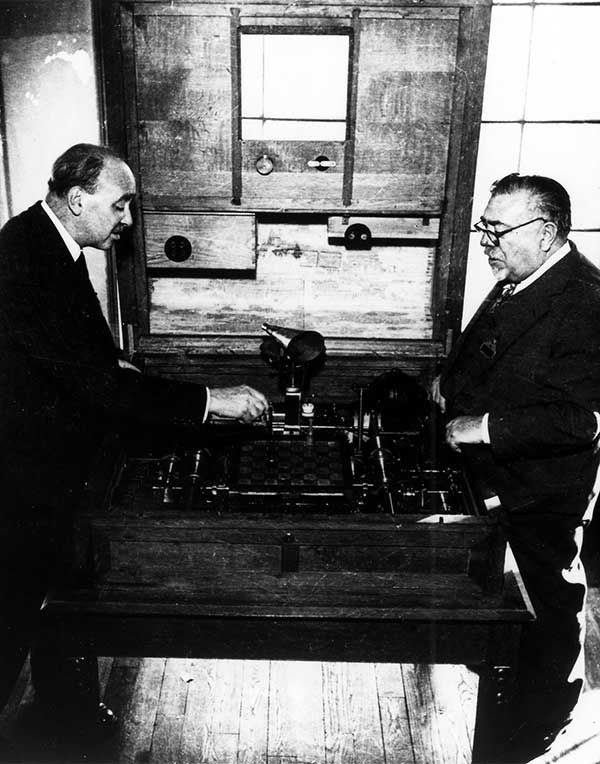 Photo: Computer History Museum Leonardo Torres y Quevedos' son Gonzalo [left] demonstrates his father's chess-playing machine for Norbert Wiener at the Paris conference.
Photo: Computer History Museum Leonardo Torres y Quevedos' son Gonzalo [left] demonstrates his father's chess-playing machine for Norbert Wiener at the Paris conference. At Couffignal's conference, Torres y Quevedo's son Gonzalo introduced or reacquainted this elite international audience to his father's works. Torres y Quevedo embraced a vision of what his son called automism," the possibility for creating ever more sophisticated autonomous machinery that could encompass actions and behaviors previously the sole domain of humans. On exhibit for the 1951 conferees was an electromagnetic chess-playing machine from the 1920s, a system called Telekino that used radio waves and servomechanisms for the remote guidance of boats, and a complex mechanical device called the endless spindle" for calculating logarithms.
Following Torres y Quevedo's morning presentation, the afternoon was given over to names that would, in time, become indelibly linked to cybernetics. W. Ross Ashby, a British psychiatrist and researcher, presented his subsequently famous Homeostat, an electronic system designed to adapt to it environment and described in his 1948 paper, Design for a Brain."
 Photo: Larry Burrows/The LIFE Picture Collection/Getty Images Neurophysiologist W. Grey Walter observes his cybernetic tortoises.
Photo: Larry Burrows/The LIFE Picture Collection/Getty Images Neurophysiologist W. Grey Walter observes his cybernetic tortoises. Ashby was followed by W. Grey Walter, a British neurophysiologist, who demonstrated his own subsequently famous light-sensitive robot tortoises." None other than Norbert Wiener himself followed, with a rather remarkable talk in which he speculated about the possibilities for computing machines to afford humanity new kinds of sensory perceptions of form-gestalt"-which are not in our nervous system." New realms of perception might be opened to a new kind of body combining mind and machine.
Other speakers that Friday afternoon included Albert Uttley, a researcher at the UK's National Physical Laboratory and a central figure in the Ratio Club, a dining club of British cyberneticists that met in the basement of a London neurological hospital. Appearing also was the Chicago neurophysiologist Warren McCulloch, who with the astonishing talent of Walter Pitts had pioneered the concept of nervous nets"-our neural nets-in 1943, with ideas for using such nets to perform logic and other calculations. At the Paris conference, McCulloch quipped, Brains are calculating machines, but man-made calculating machines are not yet brains."
Computers as models for the human brainIf the notion of McCulloch and Pitts was to create machines on the model of minds-well, at least, brains-the closing remarks for the entire conference marched in a contrary direction. The final speech fell, surely by design, to Couffignal himself. Late in the morning of Saturday, 13 January, he spoke of Several New Analogies Between the Structures of Calculating Machines and Brain Structures." Taking the brain to be a machine where thoughts are elaborated and the [sic] logic as the working-method of that apparatus," he proposed that a body of knowledge could be constructed about the actual working processes" of the brain and that these actualities could be directly compared to the ideal logic performed with computing machines."
Couffignal's aim was not to make computers think like humans, but for humans to think like computers. Why? He believed it would be good for people: On individual scale, an enlargement of social strength of intelligence can be expected," perhaps by breaking through the few steady ideas" inherited by our civilization" with which Couffignal thought humans based our actual reasoning. He concluded, and, on human scale, an encreasement [sic] of the intellectual potential." Together, by thinking like computers, humanity would create a new and improved version of itself.
While Couffignal dreamt of reasoning more like a computer, he assuredly practiced eating like a Parisian. After his conclusion to the conference, the conferees made their way across the city to the 17th Arrondissement and the Ecole Hoteliere. Opened in the 1930s, the school trained hundreds of aspiring Parisian hotel chefs. One of its restaurants boasted a replica of a dining room aboard the luxury ocean liner SS Normandie. The 1951 conference's Banquet de Cloture" was no doubt delicious, but the announcement of it showed the dyspeptic truth that only men had attended the conference proper. Any women who accompanied them, however, were invited to the banquet: Les dames accompagnato les members du Colloque sont admises au banquet."
A French project falters, a German one succeedsAfter this remarkable conference, Couffignal's career did not rise to greater heights. The Logabax Company, which was finishing work on Couffignal's pilot-machine and had started on his ambitious, memory-minimizing, parallel-design large computer, went bankrupt in 1952 and closed. Couffignal's large machine remained forever unbuilt. He and his laboratory struggled along, eventually buying an Elliott 402 computer, a rather standard vacuum-tube, stored-program computer with a magnetic drum memory. For Couffignal, the purchase must have felt, at least somewhere within him, like humiliation. The Elliott was the epitome of everything his unbuilt design was not. In 1959, he was fired.
Through a series of books published in the 1950s and 1960s on cybernetics, Couffignal earned himself a twin legacy: Today, he is generally seen as having given French digital computer manufacture something of an initial disadvantage, while at the same time he is included as an important early figure within French cybernetics.
Alwin Walther, for his part, left Paris and returned to Darmstadt, where he continued the physical reconstruction and technological evolution of his Institut fur Praktische Mathematik. Among other things, he began his own effort to create an electronic digital computer. It would take him until the end of the decade, but he succeeded in creating a vacuum tube-based machine for his institute, the DERA. In this 1963 video, Walther and his associates demonstrate DERA:
Walther must have found his Parisian experience to have been of great value, for in 1955 he and his institute organized and hosted their own large international conference on digital computing. Less fleetingly, he built up a considerable library of the available literature on computing at his institute, turning it into a key resource for the developing German computing community.
For this library, Walther had bound together the various documents he had brought home with him from Couffignal's 1951 Paris conference: the four-page printed program; the three-page typescript conference announcement; the nine-page list of attendees; and over 100 pages of abstracts for the presentations, both in English and in French. This bound volume sat on the shelves of the institute's library as item number B8807 for years.
As for the others in attendance at Couffignal's 1951 conference, their full comments were presented in French in a publication by the CNRS in 1953, under the same title as the conference. Running to over 560 pages, this record ironically remains-at least after an ardent search by this author-inaccessible freely on the Web. Nevertheless, many of the attendees have become the perennial subjects of the history of science and technology, especially computing.
With time, Walther's bound volume of his 1951 conference materials was deaccessioned by his institute's library. From there, the volume attracted the discerning eye of Jeremy M. Norman, a noted collector and dealer in rare books and manuscripts in the history of science and technology. Norman, in turn, used the volume in his and Diana H. Hook's 2002 documentary history, The Origins of Cyberspace: A Library on the History of Computing, Networking, and Telecommunications (Norman Publishing).
More recently, Norman included Walther's bound volume in a lot of rare books he donated to the collection of the Computer History Museum. The volume now resides in the Museum's archival facility in the San Francisco Bay Area, while a new PDF scan of it resides in a computer somewhere in the Microsoft Azure infrastructure, and might reside on your computer or phone should you download it here.
Another chapter in the long history of artificial intelligenceHow in the end should we think about Couffignal's 1951 conference? What do we make of it? In a 2017 piece, the computer scientist turned computing historian Herbert Bruderer considers whether the conference marked the birthplace of artificial intelligence," rather than the more famous Dartmouth Conference of 1956. He writes, This well-documented event could also be regarded as the first major conference of artificial intelligence."
This view hinges on just how one takes the phrase artificial intelligence." My own perspective is that the 1951 conference was certainly part of the building of a community: a community of people thinking about and building computers and cybernetic machines. It was a community animated by thinking about minds and machines together, also considering-some even pursuing-machines as minds. In this, the Paris conference is evidence of the long story of what we could today call artificial intelligence" and how it weaves throughout computer history.
Editor's note: This post originally appeared as Thinking About Machines and Thinking" on the blog of the Computer History Museum.
About the AuthorDavid C. Brock is an historian of technology and director of the Computer History Museum's Software History Center.
SourcesGerman computer pioneer Alwin Walther's bound papers from the 1951 conference Les Machines a Calculer et la Pensee Humaine" are in the collection of the Computer History Museum and are available here.
For more on Walther, see Wilfried de Beauclair's Alwin Walther, IPM, and the Development of Calculator/Computer Technology in Germany, 1930-1945," in Annals of the History of Computing, v. 8, no. 4, October 1986, pp. 334-350. Herbert Bruderer discusses Alwin Walther's work on DERA, in Milestones in Analog and Digital Computing, Third Edition, Springer, 2020. For more on DERA, see Klaus Biener's article Alwin Walther-Pionier der Praktischen Mathematik," August 1999 [in German]. See also the Alliance with the Nazi Regime" timeline at the Technische Universitat Darmstadt.
For more on Louis Couffignal, see Girolamo Ramunni's Louis Couffignal, 1902-1966: Informatics Pioneer in France?," Annals of the History of Computing, v. 11, n. 4, 1989, pp. 247-256, and Pierre E. Mounier-Kuhn's The Institut Blaise-Pascal (1946-1969) from Couffignal's Machine to Artificial Intelligence," Annals of the History of Computing, v. 11, n.4, 1989, pp. 257-261.
For more on Louis Lapicque, see Jean-Gael Barbara's French Neurophysiology between East and West: Polemics on Pavlovian heritage and Reception of Cybernetics," in Franco-Russian Relations in the Neurosciences, Hermann, 2011. Lapicque's papers are at the University of Texas.
Norbert Wiener's papers are held at the MIT Libraries. For more on Wiener and the evolution of cybernetics, see Cybernetics and Information Theory in the United States, France and the Soviet Union," by David Mindell, Jerome Segal, and Slava Gerovitch, in Science and Ideology: A Comparative History, Routledge, 2003, pp. 66-95.
For more on Leonardo Torres y Quevedo, see Brian Randell's From Analytical Engine to Electronic Digital Computer: The Contributions of Ludgate, Torres, and Bush," Annals of the History of Computing, v. 4, no. 4, October 1981, pp. 327-341.
W. Grey Walter and his cybernetic tortoises are discussed in Andrew Pickering's The Cybernetic Brain: Sketches of Another Future, University of Chicago Press, 2009. See also The Ratio Club: a melting pot for British cybernetics," by Olivia Solon, wired.co.uk, 21 June 2012, and Phil Husbands and Owen Holland's The Ratio Club: A Hub of British Cybernetics," from The Mechanical Mind in History, MIT Press, 2008, pp. 91-148.
For more on Walter Pitts, see Amanda Gefter's The Man Who Tried to Redeem the World with Logic," Nautilus, 5 February 2015.
Herbert Bruderer's 2017 essay The Birthplace of Artificial Intelligence?" considers the significance of the 1951 Paris conference organized by Couffignal.